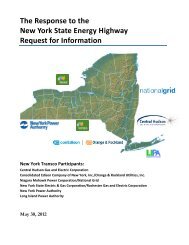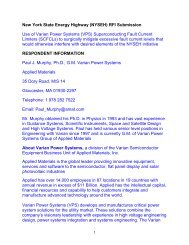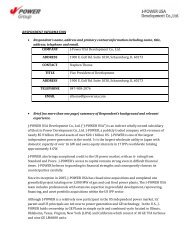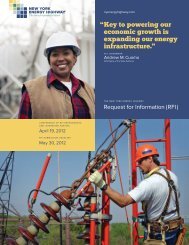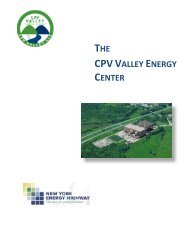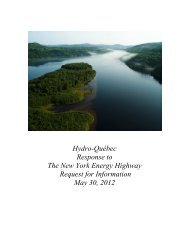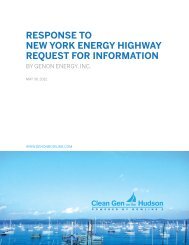Beacon Power, LLC Response to the New York Energy Highway ...
Beacon Power, LLC Response to the New York Energy Highway ...
Beacon Power, LLC Response to the New York Energy Highway ...
You also want an ePaper? Increase the reach of your titles
YUMPU automatically turns print PDFs into web optimized ePapers that Google loves.
There a several benefits of using flywheel s<strong>to</strong>rage for frequency regulation that align<br />
with <strong>the</strong> <strong>Energy</strong> <strong>Highway</strong> Objectives:<br />
1.<br />
As a new, fast, accurate resource for maintaining grid frequency, flywheel energy<br />
s<strong>to</strong>rage assures that long-term reliability of <strong>the</strong> electric system is cost-effectively<br />
maintained, benefiting system performance and operations.<br />
<strong>Beacon</strong> <strong>Power</strong>’s technology provides a fast response solution for maintaining grid<br />
reliability. With a 25 kWh/100 kW flywheel system, <strong>Beacon</strong>’s technology can respond <strong>to</strong> an<br />
ISO’s control signal up <strong>to</strong> one hundred times faster than what is offered by traditional<br />
genera<strong>to</strong>rs. Since fast regulation resources are significantly more effective at responding <strong>to</strong><br />
system imbalances than slower-ramping generation resources, <strong>the</strong>ir use on <strong>the</strong> grid can lower<br />
<strong>the</strong> overall amount of Regulation that needs <strong>to</strong> be purchased <strong>to</strong> maintain system reliability.<br />
The following example shows <strong>the</strong> greater effectiveness provided by using flywheel<br />
energy s<strong>to</strong>rage for frequency regulation. On September 25, 2011, at hour ending 16, <strong>Beacon</strong>’s<br />
flywheel regulation plant in Stephen<strong>to</strong>wn, NY supplied 20 MW of Regulation capacity <strong>to</strong> <strong>the</strong><br />
NYISO regulation market, or 11% of <strong>the</strong> <strong>to</strong>tal 175 MW of Regulation capacity procured during<br />
<strong>the</strong> hour. 1 Based upon data provided by NYISO, during that hour <strong>the</strong> <strong>to</strong>tal Area Control Error<br />
(“ACE”), which is a measurement of <strong>the</strong> frequency error and system imbalance on <strong>the</strong> grid, was<br />
44.3 MWh (<strong>the</strong> sum of positive ACE MWh with <strong>the</strong> absolute value of negative ACE MWh). 2 In<br />
this hour, <strong>Beacon</strong>’s 20 MW flywheel plant provided 14.2 MWh of energy <strong>to</strong> correct ACE or<br />
32.2% of <strong>the</strong> <strong>to</strong>tal ACE Correction due its ability <strong>to</strong> respond in seconds <strong>to</strong> <strong>the</strong> error. For <strong>the</strong><br />
same hour, <strong>Beacon</strong> <strong>Power</strong> modeled a traditional genera<strong>to</strong>r supplying 20 MW of Regulation<br />
capacity with <strong>the</strong> allowable 5-minute response time following NYISO’s pro-rated control signal<br />
derived from ACE. Based on its models, <strong>the</strong> genera<strong>to</strong>r would be dispatched <strong>to</strong> provide 3.7<br />
MWh of energy <strong>to</strong> correct ACE correction, or just 8.3% of <strong>the</strong> <strong>to</strong>tal ACE Correction needed. (See<br />
Figure 1). The blue line is <strong>the</strong> actual amount of regulation service provided by <strong>Beacon</strong> <strong>Power</strong>’s<br />
20 MW flywheel plant by responding every 6-seconds <strong>to</strong> <strong>the</strong> NYISO dispatch signal and <strong>the</strong> red<br />
line shows <strong>the</strong> amount of regulation service provided by a 20 MW resource with a 5-minute<br />
response time.<br />
1 NYISO Regulation Requirements, http://www.nyiso.com/public/webdocs/market_data/reports_info/nyiso_regulation_req.pdf,<br />
Accessed 9/26/11.<br />
2 Area Control Error (“ACE”) is defined by NERC as “The instantaneous difference between a Balancing Authority’s net actual<br />
and scheduled interchange, taking in<strong>to</strong> account <strong>the</strong> effects of Frequency Bias and correction for meter error.” ACE data<br />
provided by NYISO. System ACE data is telemetered <strong>to</strong> Stephen<strong>to</strong>wn plant in conjunction with <strong>the</strong> plant’s specific dispatch<br />
signal.<br />
3



